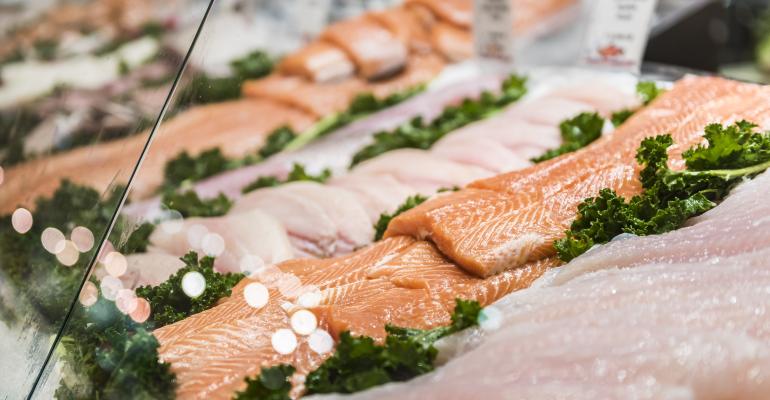Supermarket seafood department operators are awash in potential product offerings, and that is making effective merchandising increasingly complex.
Along with selecting from among hundreds of raw fresh whole fish and shellfish options, including selections that are salted, cured and smoked along with other prepared ready-to-cook and ready-to-eat options, operators also must weigh freshness, price and availability when deciding on the most appropriate selections to situate in their limited case space.
“The SKUs get out of control when considering all the cuts and forms available for each species,” said Chuck Anderson vice president and partner with Certified Quality Foods, a Dallas-based analyzer of seafood quality, and the former vice president of seafood procurement for Quincy, Mass.-based Ahold USA and the former category manager for seafood at San Antonio-based H-E-B.
“Much of the wise seafood selection is determined by what customers want, but so much of what is available and affordable is driven by supply side economics,” he said. That includes the species that are in season and coming into season; the expense of stocking particular options, and freshness levels.
“Quality is number one in driving fresh seafood sales,” he said. “Retailers can build sales and reputations with local or regional farmed or wild seafood varieties that are consistently high quality.”
Operators seeking to offer top-caliber seafood should focus on same-day delivery products that emanate from a port that is within a four-hour drive of the store or distribution center, Anderson said. Next-day delivery varieties that are within an eight- to-12-hour drive also can be of excellent quality, while three-times-a- week delivery selections can have highly acceptable quality and a satisfactory shelf life.
Yet, outlets far from the ports also can offer fresher products by working with processors and distributors to extend shelf life with better packaging, such as modified atmosphere packaging (MAP) and 10K OTR lidding film for case ready fresh fish, Anderson said. “Midwest retailers can buy very good quality wild fish from all three U.S. coasts, but logistics planning and execution become even more important as each additional day of logistics is one less day of shelf life for the product,” he added.
Indeed, quality continues to be a key factor in shopper selection of seafood, and it is growing in importance, states the Power of Seafood 2022 report, published by the Arlington, Va.-based Food Marketing Institute (FMI). “Seafood consumers closely associate quality with freshness, along with smell and appearance,” the report notes.
Offering novel and wider varieties of seafood also is important as more consumers are seeking relief from in-home cooking fatigue and limited restaurant options brought on by the pandemic, the report adds, noting that 29% of shoppers would like to try new and different types of seafood and 27% already are buying a variety of products. Twenty-three percent of consumers, meanwhile, tend to purchase the same seafood during each visit.
The most effective retailers will alter their seafood offerings based on store location, shopper demographics and overall seafood purchasing volume at the outlet, Anderson said. An urban supermarket in a college area with heavy lunchtime business, for instance, should carry additional SKUs of ready-to-eat, ready-to-cook and grab-and-go seafood, whiles stores in ethnic neighborhoods may offer more whole fish, fillets, salted fish, smoked fish and shellfish for traditional culturally inspired dishes, he noted. Lower volume supermarkets benefit from offering more options in extended shelf-life packaging.
“Seafood selections should vary in accordance with each store’s customer base,” he said. “The challenge for a chain is executing different product offerings in different stores versus having a set planogram for all stores,” he added.
Varieties also should often vary by region due to cultural and historical menu preferences and delivery schedules, Anderson said, noting that regional supply chains can differ greatly. “Seafood merchants have to be flexible and quick to modify assortment, promotion, and placement” as product demand and availability fluctuates.
Merchandisers also can offer more seafood choices by expanding the array of selections in the frozen case, said Russell Zwanka, director of the food marketing program and associate professor of food marketing at Western Michigan University in Kalamazoo. Such a move will enable retailers to offer less-popular selections, such as higher-priced shellfish, while freeing up space at the fresh food counter for higher-volume products.
Retailers can better pinpoint prepared options with the greatest sales potential via monitoring the seafood that is most popular at foodservice locations, Anderson said. “Visit local restaurants and review local menus online, as up to 70% of seafood dollars goes to restaurants.”





